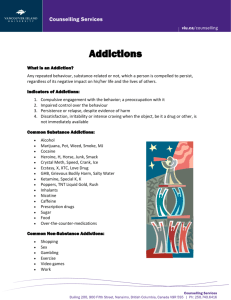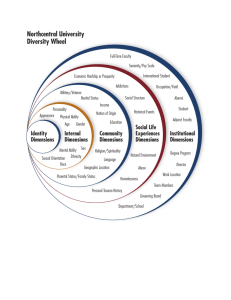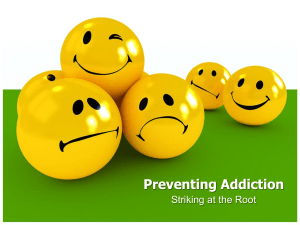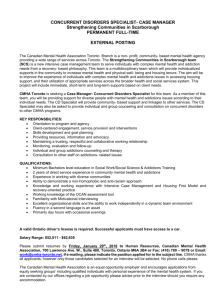Sweden
advertisement
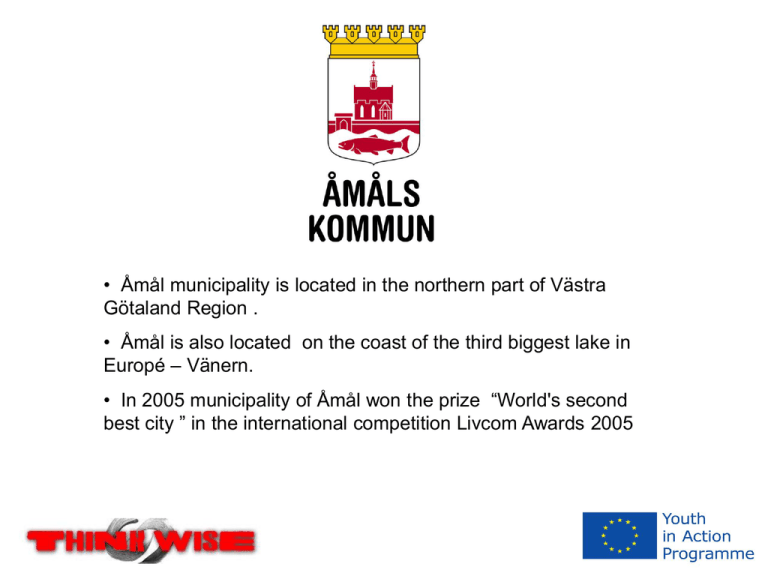
• Åmål municipality is located in the northern part of Västra Götaland Region . • Åmål is also located on the coast of the third biggest lake in Europé – Vänern. • In 2005 municipality of Åmål won the prize “World's second best city ” in the international competition Livcom Awards 2005 Consumption of alcohol • • • • • Over the eight years between 1996-97 and 2004-05, the proportion of women and men reporting a high consumption of alcohol has increased by 3 percentage points, while fewer reported a low consumption or no consumption of alcohol at all. 8% of women aged 20-84 years reported a high consumption of alcohol. 15% of men aged 20-84 years had a high level of alcohol consumption in 2004-05. High alcohol consumption indicates a quantity of alcohol corresponding to 2.5 or more bottles of wine per week for men and 2 or more bottles of wine per week for women. The alcohol consuption per person in 2011 was 9,43 liter. Smoking & Snuff-taking • • • • Over the past 25 years, the proportion of daily smokers has decreased from 35 percent to 14 percent among men and from 28 to 18 percent among women. Smoking is more common among manual workers and among those with a lower level of education. In 2004-05, 27 percent of men (16-84 years) and 5 percent of women took snuff. In the youngest age group, 16-24 year olds, 33 percent of men and 11 percent of women took snuff. Drug use • Sweden's early problems were with amphetamines in different forms. They started in 1938 when amphetamines were legal. • Still, amphetamines constitute Sweden's largest category of illicit drug abuse at 35%. • • Opiates fall in second place in Sweden, with 32%. Cannabis is third with 20%. How we work against addictions We have: 1. 2. 3. 4. 5. 6. 7. Motivationsgroups STAM – STructured Activity and Motivationgroup Routing (course) The alarm clock (course) NADA - National Acupuncture Detoxification Association Housing support Advice & Assistance Our metods: 1. ASI - Addiction Serveity Index (is a structured interview that includes questions of relevance to the client's substance abuse problems.) 2. 3. 4. 5. 6. ADAD - Adolescent Drug Abuse Diagnosis IDS 100 - Inventory of Drinking Situations MI - Motivating Interviews CRA - Community Reinforment Approach KBT – Cognitive behavioral therapy Routing Routing is a course for people who have problems with alcohol and drugs. The participants in the course meet each other 1 time per week and then 1 time per month. The whole course consist of 13 meetings. • Meeting 1 – What is motivation? • Meeting 2 – Choosing the right direction. • Meeting 3 – About the consumtion • Meeting 4 – What is good and what is not • Meeting 5 - Visit • Meeting 6 – Reactions from other • Meeting 7 – Conversation about addictions • Meeting 8 – It is you who choose the way! • Meeting 9 – Listen to a famous authors books • Meeting 10 – To look ahead • Meeting 11 – 13 – After treatment The alarm clock The alarm clock is a course for people who want to have an alcohol and drug free life. The participants in the course can be from 3 to 8 persons. They meet each other 1 time per week and have different activities and homeworks. The whole course consist of 18 meetings. • Meeting 1 – Introduction • Meeting 2 – Presentation and the participants answers some questions • Meeting 3 – IDS 100 (Inventory of Drinking Situations) is used to identify situations that encourage the consumption of alcohol / drugs. • Meeting 4 – Conversation about addictions • Meeting 5 – Conversation about addictions and watching to "The brain's reward system" movie. • Meeting 6 – Managing cravings • Meeting 7 - Dealing with thoughts of alcohol / drugs • Meeting 8 - Unsolved problems as a risk factor for relapse • Meeting 9 – To say no to alcohol and drugs • Meeting 10 - Being wise after the event in advance • Meeting 11 - plans for unexpected events • Meeting 12 – Summary • Meeting 13 – 17 – Relapse • Meeting 18 – The course ends Thank you for your attention!

